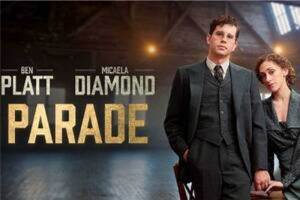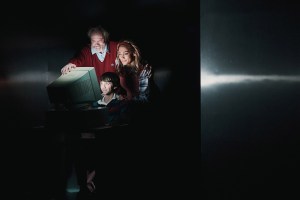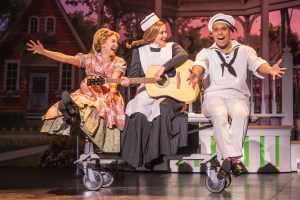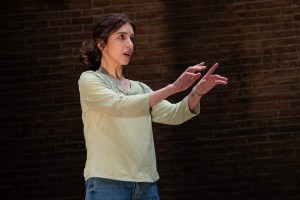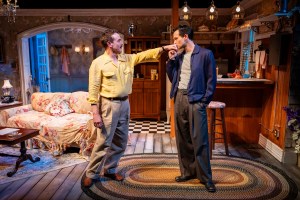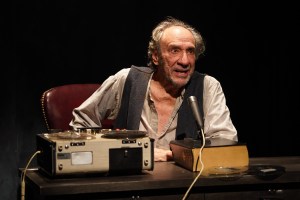Review: Parade Rewrites Its Broadway Story With a Vindicating Revival
Michael Arden mounts his New York City Center production of Jason Robert Brown and Alfred Uhry’s dark musical on Broadway.
(© Joan Marcus)
For the brief time Parade was on Broadway in the winter of 1998-99, I’m sure a handful of confused tourists were lured in by the title and discovered too late that they had signed up for a musical about murder, antisemitism, and the mob mentality of the post-Confederacy South. The production lasted only 85 regular performances and lost the Best Musical Tony Award to the song-and-dance revue Fosse despite winning for both Book (Alfred Uhry) and Score (Jason Robert Brown, in his Broadway debut).
It’s a familiar story of art versus entertainment — and if we took an official count of all the confetti cannons on Broadway, we’d see pretty clearly which one ticket buyers favor. However, Broadway longevity can’t buy you acolytes like Parade‘s. That deep affection is what made the musical New York City Center’s pick for its gala presentation this past fall, and what gave Michael Arden’s simple yet stunning production the fast track to the Jacobs Theatre this spring. Now with 24 years of retrospective appreciation under its belt, Parade is back on Broadway to remind audiences what musical theater can really do.
The show follows the bungled 1913 murder trial of Leo Frank — a Jewish man from Brooklyn who moved south for a position as superintendent of a pencil factory in Atlanta. When his 13-year-old employee Mary Phagan (a very sweet Erin Rose Doyle who is given one of the production’s more ham-fisted pieces of staging) is found dead in the factory basement, public opinion is quick to turn against him. The antisemitic fires are stoked by prosecutor and future Governor Hugh Dorsey (the perfectly despicable Paul Alexander Nolan) and the passive Governor John Slaton (an excellent Sean Allan Krill), whose crisis of conscience comes too late. Witnesses are bribed, coached, and threatened, and Frank is handed a death sentence that is ultimately carried out by a lynch mob.
It’s the inevitable conclusion of a murder committed on Confederate Memorial Day, a yearly celebration of southern pride that stands in the not-too-distant shadow of the “northern aggression” that burned Atlanta to the ground. In all its melodious splendor, “The Old Red Hills of Home” — Brown’s anthem to Southern dignity and arguably one of musical theater’s best opening numbers — furtively casts the die (Charlie Webb boasts a lovely tenor voice, opening the number as the Civil War-era Young Soldier). Meanwhile, in a seamless display of meaning meeting functionality, scenic designer Dane Laffrey’s central wooden platform reveals itself to have been the gallows all along (the set seems to have benefited from losing a layer of height since the City Center run).
Tony-winning Dear Evan Hansen alum Ben Platt stars as Frank and has beautifully graduated from his period as Broadway’s most controversial teenager, delivering a mature, textured, and fabulously sung performance as this cultural fish-out-of-water. He draws on some familiar tics and mannerisms, but they all add up to a man who baffles his neighbors with high-brow sensibilities and a stoic demeanor that might fit comfortably at a New York shul but is hostile to every sense of Southern decorum. Micaela Diamond, who was introduced to Broadway as the youngest of the Chers in The Cher Show, proves the breadth of her talent as Leo’s Southern-born and fully assimilated wife Lucille. Her accent may slip in and out, but her yearning for connection with her character’s distant husband is palpable, and her performance of “You Don’t Know This Man” is one for the ages.
If nothing else, this production demonstrates exactly why Brown’s genre-spanning score won the Tony all those years ago. And now we have the privilege of hearing it in its most sublime form: Platt and Diamond perfectly duet on “This Is Not Over Yet,” which carries crushing tragedy in its hopeful façade; the wonderful Kelli Barrett takes the witness stand as Mrs. Phagan to sing the elegiac lullaby “My Child Will Forgive Me”; Jay Armstrong Johnson performs the bluesy “Big News!” as slimy reporter Britt Craig; Jake Pedersen is vocally astonishing as young Frankie Epps in the mournful-turned-enraged “It Don’t Make Sense”; and Alex Joseph Grayson, as star witness Jim Conley, stops the show with his gospel-infused vaudeville act, “That’s What He Said.”
Brown’s composite score epitomizes the range of cultures bumping up against one another in the early 20th-century South, and Arden’s staging (a beautiful collaboration with choreographers Lauren Yalango-Grant and Christopher Cree Grant) shows precisely how these frictions can burst into flames. When his cast is not peering from the sidelines, they are churning with motion that is alternatingly exhilarating and terrifying — often both at the same time (lighting designer Heather Gilbert artfully follows these tonal shifts).
This is where Parade transcends documentary and proves its power as a piece of theater. Arden does incorporate documentary-style elements — photographs of each person involved in the Frank case are projected behind the actors as characters are introduced (Sven Ortel’s projection designs are aesthetically complemented by costume designer Susan Hilferty’s muted color palette). But the effect goes beyond a simple reminder that the events and individuals depicted are real. It’s a snapshot of a past that is bleeding into the present just as inconspicuously as our silver-voiced Confederate soldier evolved into a member of Leo Frank’s lynch mob. There are plenty of heavy-handed nods Arden could have made to the modern-day relevance of this story (including a certain neo-Nazi demonstration that took place just outside the Jacobs). Blessedly, he knows Parade can sing for itself.


